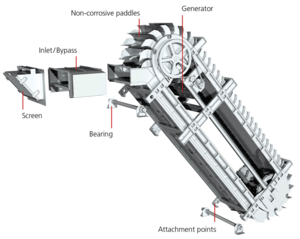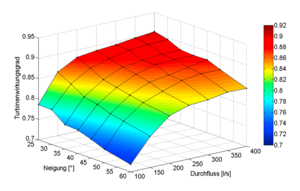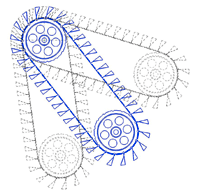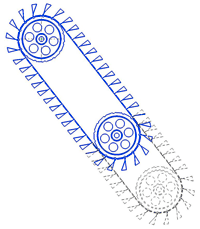Difference between revisions of "Steffturbine - Hydropower Turbine"
***** (***** | *****) |
***** (***** | *****) m (Fungai Cecilia Sandamu moved page Steffturbine to Steffturbine - Hydropower Turbine without leaving a redirect) |
||
| (28 intermediate revisions by 3 users not shown) | |||
| Line 1: | Line 1: | ||
| − | = | + | = Harnessing Water Power in Small-scale Topographic Settings<br/> = |
| − | + | In the search for methods of power generation that are as eco-friendly as possible, the harnessing of water power is becoming increasingly important. Of particular interest are solutions in the smallest application area, with low heads and limited throughflow. These micro power plants allow water resources in small-scale topographic settings to be harnessed and converted into electrical energy. | |
<br/> | <br/> | ||
| − | = | + | = Engineering Concept<br/> = |
| − | + | The Steffturbine has been developed in response to this requirement. The small turbine is based on the principle of the [http://en.wikipedia.org/wiki/Overshot_waterwheel overshot waterwheel] and essentially exploits the potential energy of water. Its main components are a continuous double chain running around two guide wheels and supporting stainless-steel paddles (Fig. 1). An integrated permanent magnet generator converts mechanical output into AC electrical power.
The design of the Steffturbine is modular; its length can be varied and adjusted to suit the local topography. Depending on the terrain, it is possible to operate several Steffturbines side-by-side in order to achieve a higher total output (Fig. 2). | |
| + | |||
| + | {| border="0" cellspacing="1" cellpadding="5" style="width: 500px;" align="center" | ||
| + | |- | ||
| + | | [[File:Steffturb Komp E 800 Px.png|thumb|center|300px|Fig. 1: The components of the Steffturbine]] | ||
| + | | [[File:Steffturbine Parallel 800 Px.png|thumb|center|285px|Fig. 2: The Steffturbine is based on a modular concept]] | ||
| + | |} | ||
<br/> | <br/> | ||
| − | + | = Output and Efficiency<br/> = | |
| − | + | A head of 3 to 5 metres will create the ideal operating conditions for the Steffturbine, when the small-scale system will achieve an output of 12 kW. At its current stage of technical development, measurements show that [http://en.wikipedia.org/wiki/Electrical_efficiency efficiency] peaks at 92 percent (Fig. 3). | |
| − | + | [[File:Steffturb Wirkungsgrad 800 Px.png|thumb|center|300px|Fig. 3: Efficiency in relation to inclination and water throughflow]] | |
<br/> | <br/> | ||
| − | + | = Applications<br/> = | |
| − | + | The compact Steffturbine has a diverse range of applications. Rivers and streams, dam outlets, water treatment plants, irrigation systems, power station outflow channels and industrial process water are all suitable for power generation, along with locations by old mills or wiers in need of revitalization. The inclination of the Steffturbine can be adjusted to suit the local topography. In extreme cases, it is possible to generate electricity from the kinetic energy of water flowing horizontally (Fig. 4 and Fig. 5).<br/> | |
| − | + | The electricity generated by the Steffturbine can be fed to the grid, used as part of an isolated solution, or integrated into a combined network with other power generating systems (geothermal, solar, wind). Thanks to the adaptability of the Steffturbine, it is possible to install it without disturbing the ecosystem. | |
| + | |||
| + | {| border="0" cellspacing="1" cellpadding="5" style="width: 500px;" align="center" | ||
| + | |- | ||
| + | | style="border-color: rgb(255, 255, 255);" | [[File:Steffturb Neigung 200 Px.png|frame|left|235px|Fig. 4: The inclination of the Steffturbine can be adjusted to the topography]] | ||
| + | | style="background-color: rgb(255, 255, 255); border-color: rgb(255, 255, 255);" | [[File:Steffturb Laengenvar 200 Px.png|frame|right|200px|Fig. 5: The length of the Steffturbine can be varied]] | ||
| + | |} | ||
<br/> | <br/> | ||
| − | + | = A Swiss Development<br/> = | |
| − | |||
| − | = | ||
| − | + | The Steffturbine is a development of WRH Walter Reist Holding AG working together with the University of Munich. WRH Walter Reist Holding AG, with headquarters in Hinwil (Switzerland), is an international, family-owned company specialized in the development of innovative conveyor and processing systems with proven and successful applications in the printing, food and pharmaceutical industries, as well as in automobile manufacturing. The conveyor technology also forms the basis for the Steffturbine, which has been marketed by WRH Walter Reist Holding AG since 2012 through its own worldwide sales and distribution organization. | |
<br/> | <br/> | ||
| − | = | + | = Projects in Italy and Tanzania<br/> = |
| − | + | Initial projects with the Steffturbine are underway. In Nyangao, in the Lindi region of Tanzania, a small-scale hydroelectric power plant is planned. A Steffturbine will supply electricity to a school and adjacent houses as part of a self-sufficient system, with the dam outlet from a small reservoir being harnessed as a source of hydro power. | |
| − | + | The realization of a further Steffturbine project is scheduled for the region around Parma (Italy). Two irrigation systems bringing water to arable land will serve as the energy source, and the power thus generated will be fed into the grid. | |
<br/> | <br/> | ||
| − | + | = Further Information = | |
| − | <br/> | + | *[http://www.steffturbine.com/en/ steffturbine.com] |
| + | *[http://www.walter-reist-holding.com/en/ walter-reist-holding.com] | ||
| + | *[[Portal:Hydro|Portal:Hydro]] | ||
| + | *[[Hydro_Power_-_Civil_Engineering|Hydro Power - Civil Engineering]]<br/> | ||
<br/> | <br/> | ||
| − | = | + | = References = |
| − | + | <references /><br/> | |
| − | |||
| − | |||
| − | <br/> | ||
| − | + | [https://www.baufachinformation.de/zeitschrift/Die-Steffturbine-eine-auf-einem-Umlaufband-beruhende-Kleinwasserkraftanlage/2011109014900 [1]] Malcherek A., Kulisch H., Maerker C.: Die Steffturbine – eine auf einem Umlaufband beruhende Kleinwasserkraftanlage. WasserWirtschaft 10 | 2011, pp. 30–33. | |
| − | [ | + | [http://www.vms-detmold.de/index.php/wtw-informationen-vorschau-archiv?aus=1&jahrgang=2012&heft=12&s_sw_url=steffturbine [2]] Maerker C., Trachsler M., Widmer F.: Ein Jahr Steffturbine in Rüti/Schweiz – Erfahrungen aus dem laufenden Betrieb einer Pilotanlage in der Schweiz. Wassertriebwerk 12 | 2012, pp. 232–237.<br/> |
| − | [ | + | [[Category:Micro_Hydro]] |
| + | [[Category:Tanzania]] | ||
| + | [[Category:Italy]] | ||
| + | [[Category:Hydro]] | ||
Latest revision as of 14:03, 21 July 2014
Harnessing Water Power in Small-scale Topographic Settings
In the search for methods of power generation that are as eco-friendly as possible, the harnessing of water power is becoming increasingly important. Of particular interest are solutions in the smallest application area, with low heads and limited throughflow. These micro power plants allow water resources in small-scale topographic settings to be harnessed and converted into electrical energy.
Engineering Concept
The Steffturbine has been developed in response to this requirement. The small turbine is based on the principle of the overshot waterwheel and essentially exploits the potential energy of water. Its main components are a continuous double chain running around two guide wheels and supporting stainless-steel paddles (Fig. 1). An integrated permanent magnet generator converts mechanical output into AC electrical power. The design of the Steffturbine is modular; its length can be varied and adjusted to suit the local topography. Depending on the terrain, it is possible to operate several Steffturbines side-by-side in order to achieve a higher total output (Fig. 2).
Output and Efficiency
A head of 3 to 5 metres will create the ideal operating conditions for the Steffturbine, when the small-scale system will achieve an output of 12 kW. At its current stage of technical development, measurements show that efficiency peaks at 92 percent (Fig. 3).
Applications
The compact Steffturbine has a diverse range of applications. Rivers and streams, dam outlets, water treatment plants, irrigation systems, power station outflow channels and industrial process water are all suitable for power generation, along with locations by old mills or wiers in need of revitalization. The inclination of the Steffturbine can be adjusted to suit the local topography. In extreme cases, it is possible to generate electricity from the kinetic energy of water flowing horizontally (Fig. 4 and Fig. 5).
The electricity generated by the Steffturbine can be fed to the grid, used as part of an isolated solution, or integrated into a combined network with other power generating systems (geothermal, solar, wind). Thanks to the adaptability of the Steffturbine, it is possible to install it without disturbing the ecosystem.
A Swiss Development
The Steffturbine is a development of WRH Walter Reist Holding AG working together with the University of Munich. WRH Walter Reist Holding AG, with headquarters in Hinwil (Switzerland), is an international, family-owned company specialized in the development of innovative conveyor and processing systems with proven and successful applications in the printing, food and pharmaceutical industries, as well as in automobile manufacturing. The conveyor technology also forms the basis for the Steffturbine, which has been marketed by WRH Walter Reist Holding AG since 2012 through its own worldwide sales and distribution organization.
Projects in Italy and Tanzania
Initial projects with the Steffturbine are underway. In Nyangao, in the Lindi region of Tanzania, a small-scale hydroelectric power plant is planned. A Steffturbine will supply electricity to a school and adjacent houses as part of a self-sufficient system, with the dam outlet from a small reservoir being harnessed as a source of hydro power.
The realization of a further Steffturbine project is scheduled for the region around Parma (Italy). Two irrigation systems bringing water to arable land will serve as the energy source, and the power thus generated will be fed into the grid.
Further Information
References
[1] Malcherek A., Kulisch H., Maerker C.: Die Steffturbine – eine auf einem Umlaufband beruhende Kleinwasserkraftanlage. WasserWirtschaft 10 | 2011, pp. 30–33.
[2] Maerker C., Trachsler M., Widmer F.: Ein Jahr Steffturbine in Rüti/Schweiz – Erfahrungen aus dem laufenden Betrieb einer Pilotanlage in der Schweiz. Wassertriebwerk 12 | 2012, pp. 232–237.
























